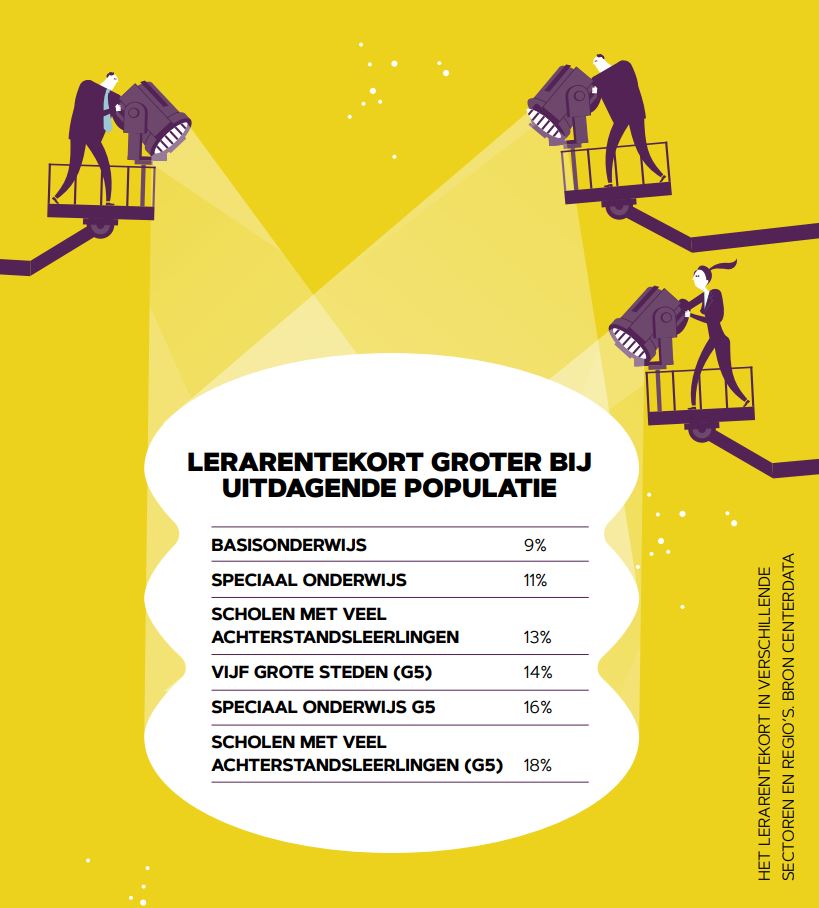The fight against teacher shortages in disadvantaged schools requires more than extra salary
The so-called labor market allowance for staff at disadvantaged schools is here to stay. After two years, the temporary measure will become permanent after the summer. Whether the allowance is effective will not become clear until the end of 2023 at the earliest.

Picture: Type tank
SBO De Poldervaart is looking for a super teacher! 0,6–1,0 working time factor - with a view to permanent employment. And as an extra: De Poldervaart is a school that uses the labor market allowance. This means a nice monthly addition to your salary.
When the labor market allowance for disadvantaged schools in primary and secondary education was suddenly introduced in 2021, schools were still hesitant to advertise the extra. Not surprising, because it was a temporary measure for two school years. A stroke of luck for the staff of the 15 percent of schools with the highest deprivation scores across the country.
Now that the allowance will become structural after the summer, in accordance with agreements in the coalition agreement and the education agreement, that hesitation has disappeared. It has now become 'a nice monthly addition', as school board Primo Schiedam described it at the beginning of this year on a job site.
And indeed, the bonus is ticking. For all staff at the schools involved: support staff, teacher and the director. On average, this is 8 percent, which is often somewhat higher in primary education and lower in secondary education.
You can read this article for free from the Education Magazine of January 2023. Would you like to stay informed of everything that is happening in education? Join the AOb! And receive the Education magazine ten times a year.
CHECK ALL THE BENEFITS OF MEMBERSHIP
In April, the ministry, the trade unions and the education employers will meet to see how the temporary measure will be incorporated into the collective labor agreement. One thing is certain: for primary education, the percentage will go down in the new collective agreement, as the education budget shows.
The background to this reduction is that teachers' salaries in primary school have been raised to the level of secondary education, so that the allowance can also be leveled and costs less. It remains to be seen how it will all work out, as negotiations on this part of the new collective labor agreement will start next month.
It works with us
Effectiveness
The most important question remains: does the allowance make sense? According to the ministry, this was introduced because schools with many pupils at risk of educational disadvantage have more difficulty finding and retaining staff than other schools.
The Rutte IV cabinet, which included the labor market allowance as a permanent feature in the coalition agreement, has full confidence in its effectiveness. But the CPB is still investigating whether the bonus will retain staff and whether more teachers will transfer to disadvantaged schools. The first results will not be known until the end of 2023 at the earliest, the final report will follow a year later. School boards that receive the allowance meanwhile have mixed opinions.
“It works for us, it is important for the preservation of people,” says Harry Dobbelaar, director of Zonova. This school board in Amsterdam Southeast has nineteen primary schools, eighteen of which are eligible for the labor market allowance. All staff members of those schools receive an additional 10,5 percent per month.
On top of that comes the Amsterdam allowance of almost 2.000 euros for a full-time job. “Evaluation by research agency Regioplan in Amsterdam shows that teachers consider remuneration important,” says Dobbelaar. “About two-thirds indicate that as a factor for working or continuing to work in the city. The shortage has increased everywhere in the city, the difference between schools with many pupils at risk of disadvantage and other schools has remained about the same. The allowances therefore appear to work to retain employees.”

Regions with many disadvantaged schools find it more difficult to fill vacancies and appoint an above average number of support staff. At primary schools, the share of support staff has risen sharply in cities such as Amsterdam, Rotterdam and The Hague. In some schools, especially disadvantaged schools, that percentage rises to 30 to 40 per team, according to the latest figures from the Ministry of Education. Source: DUO primary education personnel data, reference date October 2021.
Cabinet continued grant, despite criticism
The allowance for disadvantaged schools was introduced in three steps. In 2020, the municipality and school boards in Amsterdam were the first to choose to convert money from an emergency plan for the major cities into a bonus for the city and an extra allowance for underprivileged schools. Other large cities use money from the emergency plan to reduce the workload with extra support staff and more guidance for starters.
At the beginning of 2021, the National Education Program suddenly shows a labor market allowance for the 15 percent of schools with the highest disadvantage score. There has been fierce discussion about this between the major cities. Rotterdam in particular is critical, but the labor market allowance will be introduced, initially temporarily.
In the elections of 2021, D66 has included the allowance in the election program and it will become final in the new coalition agreement. Rotterdam's criticism remains valid: if there is a glaring shortage of teachers across the country, will a bonus for underprivileged schools have any effect? The CPB will investigate.
Parking lots
Not that this solves the problems, the shortage throughout Amsterdam and therefore also in Zuidoost remains high. “Tackling the shortage is a matter of a one, one, and one approach. So in addition to arranging the allowance for parking spaces, as a board we pay a larger travel allowance ourselves, we have agreements with a large housing association about housing for teachers, we organize ample opportunities for training and development, and so on. In addition, in schools with many pupils with a higher risk of falling behind, staff are better rewarded.”
Dobbelaar thinks more needs to be done. One of the schools works with an adapted programme, a five-day school week with four longer teaching days and a talent day. The latter is filled in by other personnel. “That brings a lot of peace. We are now going to look at how we can organize more flexibility at other schools as well. Because we would like qualified teachers for the group, but there are not enough teachers, so that requires more room in regulations.”
Distinction
Due to the temporary nature of the allowance, the Lucas Education school board in The Hague opted for a clear distinction between salary and bonus at the start. The allowance is not paid monthly, but once per quarter. “If you pay the allowance monthly, it quickly feels like something structural,” says Marja Holsheimer, head of the human resource management department. “At the start there was still great uncertainty about this, so we wanted to prevent it from being seen as a structural part of the salary.”
You don't get fish from an empty pond, an extra allowance won't change that
At Lucas, 20 of the 47 primary schools receive the grant and 15 of the 34 secondary schools. According to the scheme, this can vary per location between 5 and 12 percent. In consultation with the staff section of the Participation Council, this has become 8,5 percent for primary school staff and 7,5 percent for secondary education. But does the allowance have an effect? “No, it didn't help us,” says Holsheimer resolutely. “Neither in primary nor in secondary education.”
The deficit is so great that such an allowance can have little effect. “You don't get fish from an empty pond, an extra allowance won't change that. You see this problem not only with the labor market allowance, but with all the extra budget from the National Education Programme. There is not enough staff.”

Source: Center data, reference date October 2022.
The school board therefore mainly focuses on reducing the workload. According to Holsheimer, it is inevitable to have a discussion about the definition of teaching time. “When someone calls in sick in primary education, there is no lesson if you don't have an authorized replacement. This is easier to solve in secondary education, where someone can supervise independently working pupils. And in general, tinkering with teaching time is not the right solution, which lies in organizing it differently, more space for other staff.”
A school with a score of 14 percent highest at a disadvantage gets nothing and a school with a score of 16 percent gets everything
Without consultation
Called a 'slob discharge' AObdirector Thijs Roovers introduced the labor market allowance. In 2021, unions and employers refused to include the allowance in the collective labor agreement, because it was a temporary measure. “No one is against making the profession more attractive,” he says now, “but at the time it was thrown into education without any consultation and was not structural.”
There is now structural money for the allowance. AOb-members who get it, according to Roovers, have become accustomed to it and do not like to see it disappear again. But it still lacks hard data that it works. “And we are still faced with the inequality between schools. A school with a score of 14 percent highest at a disadvantage gets nothing and a school with a score of 16 percent gets everything. Schools that are a few hundred meters apart often have a big difference in budget. That is inexplicable.”
Moreover, there is a chance that teachers from schools that do not receive a bonus will transfer to a school with an allowance. “The problem will only shift.”
Critical
Employer organizations such as the PO council were critical at the time, but now, just like the unions, are discussing with the ministry to see in what form the labor market allowance can be given a place in the collective labor agreement. “That has been agreed in the education agreement and our signature is on it,” says spokesman Thijs den Otter of the Primary Education Council.
The school boards have mixed opinions about the measure, he notes. Positive for the schools that have the allowance, negative for those who have failed. For the group of schools that do have a lot of arrears, but do not receive money for the allowance, the PO council wants to see together with unions and the ministry "whether the contrast can be reduced somewhat".
Working with challenging students is becoming less attractive
During the first wave of shortages, in 2001, it quickly became clear that disadvantaged schools suffered relatively more from the lack of qualified teachers. The then Inspector General Kete Kervezee therefore argued for better pay for teachers in deprived neighbourhoods.
It didn't happen because the teacher shortage disappeared again, for a while.
Nevertheless, education has two schemes that you could consider as allowances. Special education traditionally rewards teachers in a higher scale than primary education. Moreover, there too the classes were smaller. That combination made working attractive enough to attract staff.
In secondary education, with the introduction of the job mix in 2008 in the Randstad, schools received a budget to place more teachers in higher scales. As a compensation for the higher cost of living. It should prevent teachers from leaving for schools outside Randstad. In a study from 2015, the CPB concluded that this salary incentive hardly works.
In the meantime, the position of special education and disadvantaged schools has changed drastically. Due to new regulations, mergers and cutbacks, the classes have become fuller in both.
This has an impact on the quality of education and on the workload. The attractiveness of working at what is nowadays called 'schools with a challenging population' has visibly decreased. Schools for special education or with a high deprivation score have the highest teacher shortages. And in the big cities it is even worse.


